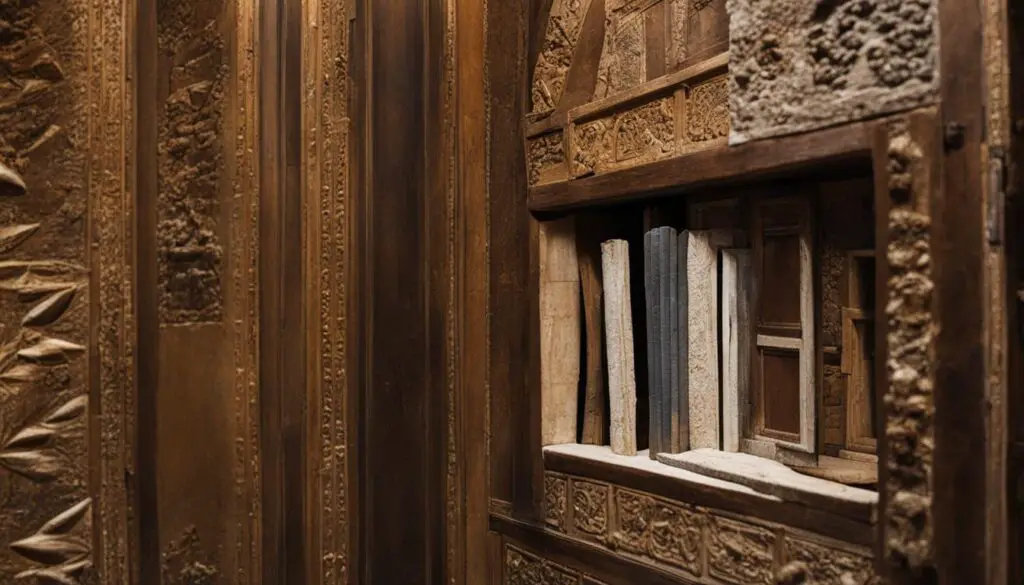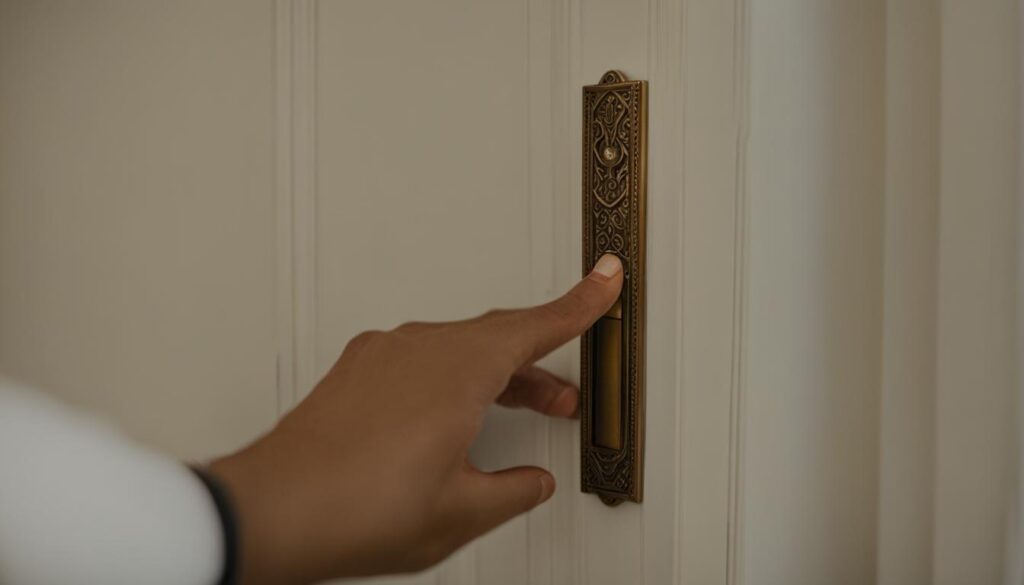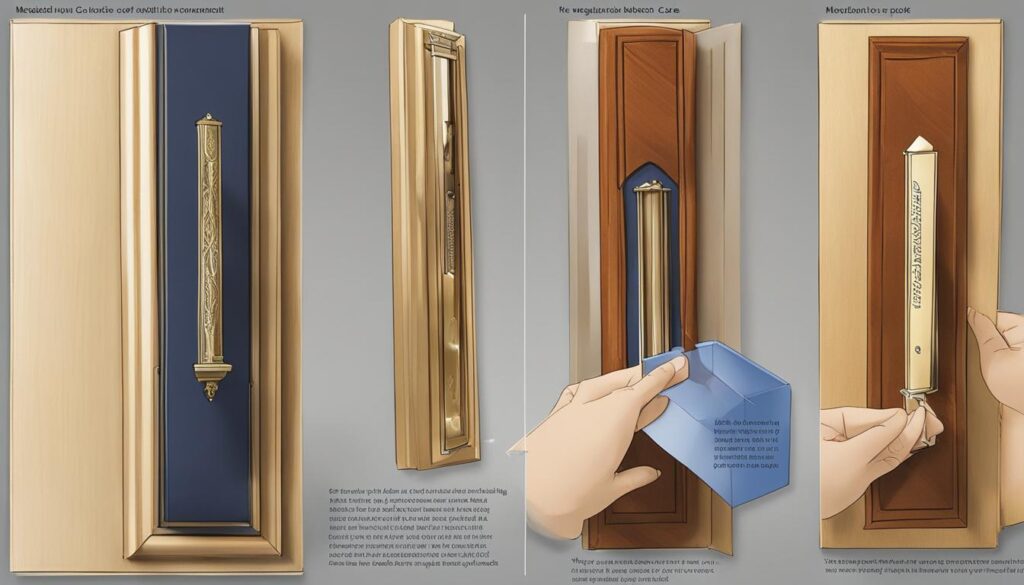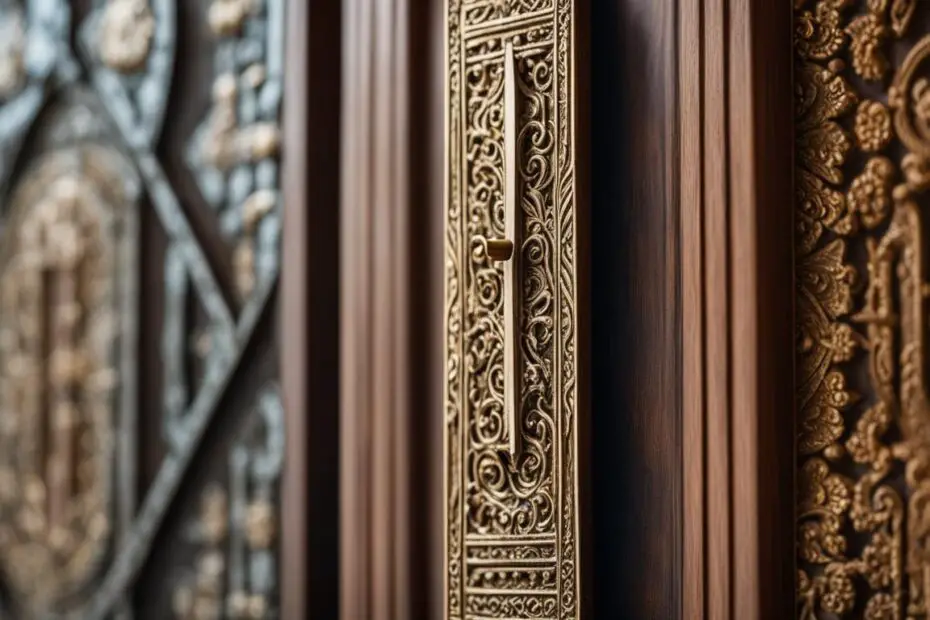A mezuzah is a small box containing a parchment scroll with verses from the Torah inscribed on it. It is placed on the right doorpost of Jewish homes as a symbol of the covenant with God and a reminder of the Jewish way of life. The mezuzah serves as a spiritual guide and is believed to bring special protection to the residents of the home. In this guide, we will explore the origins and importance of prayer mezuzah hanging and provide tips on how to properly hang a mezuzah in your own home.
Key Takeaways:
- Prayer mezuzah hanging is a cherished tradition in Jewish homes.
- The mezuzah serves as a reminder of the covenant between the Jewish people and God.
- Hang a mezuzah on every living space’s doorpost, except for rooms like bathrooms and closets.
- Affix the mezuzah on the right side of the doorpost, lower part of the top third, at a slant.
- Prayer mezuzah hanging keeps Jewish faith and identity alive for future generations.
The Origins of the Mezuzah
The mezuzah has a deep-rooted biblical origin that dates back to ancient times. It is mentioned in the Torah, specifically in the book of Deuteronomy, where the commandment to inscribe the verses of the Shema prayer on the doorposts of Jewish homes is given. This commandment serves as a reminder of the covenant between the Jewish people and God and carries great significance in Jewish tradition.
The word “mezuzah” itself refers to both the case or container that holds the parchment scroll and the scroll itself. The mezuzah scroll contains hand-written verses from the Torah, specifically Deuteronomy 6:4-9 and 11:13-21. These verses are inscribed by a kosher scribe using special ink and meticulous techniques to ensure their accuracy and sanctity.
In addition to its religious significance, the mezuzah also symbolizes the creation of a Jewish household that adheres to a set of rules, rituals, and beliefs. It serves as a daily reminder of the Jewish way of life and provides a spiritual guide for those who dwell within the home.
The Role of Mezuzah in Jewish Life
Mezuzahs have been an integral part of Jewish life for centuries, serving as a tangible representation of Jewish faith and identity. By affixing a mezuzah on the doorposts of their homes, individuals declare their allegiance to God and their commitment to living a Jewish life. It creates a sense of continuity and connection to the Jewish community and traditions.
“The mezuzah protects and guards the home, keeping evil forces at bay and inviting blessings and protection into the lives of those who reside within.” – Rabbi David Wolpe
The mezuzah also plays a role in establishing a sacred space within the home. It serves as a constant reminder of God’s presence and the values and responsibilities that come with being part of the Jewish faith. The act of hanging a mezuzah is seen as a mitzvah, a commandment, and an opportunity for individuals to deepen their spiritual connection and express their devotion to God.
Overall, the mezuzah holds great significance in Jewish tradition, serving as a symbol of identity, faith, and protection. Its origins in the Torah and its continued practice in Jewish homes around the world highlight its enduring importance in keeping the traditions of the Jewish people alive.

Where and When to Hang a Mezuzah
When it comes to hanging a mezuzah, it is important to consider both the location and timing for this sacred ritual. A mezuzah should be affixed to the doorpost of every living space in the house, not just the entrance door. Any room with two doorposts and an overhead lintel requires a mezuzah. However, rooms such as bathrooms, closets, and laundry rooms do not require a mezuzah.
As for the timing, it is recommended to hang a mezuzah as soon as possible after moving into a new home. According to Jewish tradition, one should not wait longer than thirty days to hang a mezuzah. However, in the Land of Israel, this 30-day rule does not apply, and a mezuzah should be affixed to the door when moving in.
It is important to follow these guidelines to ensure that every living space within the home is properly adorned with a mezuzah, fostering a sense of spiritual connection and protection.

Table: Spaces that Require a Mezuzah
| Space | Requires a Mezuzah? |
|---|---|
| Entrance Door | Yes |
| Living Room | Yes |
| Kitchen | Yes |
| Bedroom | Yes |
| Bathroom | No |
| Closet | No |
| Laundry Room | No |
By adhering to the guidelines of where and when to hang a mezuzah, individuals can ensure that their homes are adorned with this sacred symbol, fostering a deep connection to their faith and Jewish heritage.
How to Affix a Mezuzah
Properly affixing a mezuzah is an important ritual in Jewish tradition. It involves following specific guidelines to ensure the mezuzah is placed correctly and securely on the doorpost. Here are the steps to hang a mezuzah:
- Choose the right location: The mezuzah should be placed on the right side of the doorpost as one enters a room. It should be affixed to the lower part of the top third of the doorpost, generally at eye level for a six-foot-tall person.
- Prepare the doorpost: Before affixing the mezuzah, make sure the doorpost is clean and free from any debris or obstructions.
- Affix the mezuzah: Hold the mezuzah case at a slight slant, with the lower part of the container facing the person entering the room. Attach the case securely at the top and bottom to prevent it from falling.
- Recite the blessing: As you affix the mezuzah, recite the following blessing: “Baruch atah Adonai, Eloheinu Melech haolam, asher kidshanu b’mitzvotav v’tzivanu likboa mezuzah.” This blessing acknowledges God’s commandments and sanctifies the home.
It is important to note that affixing a mezuzah is not just a physical act but a spiritual one as well. The mezuzah serves as a daily reminder of the covenant between God and the Jewish people, and by hanging it in your home, you are declaring your commitment to living a Jewish life.

The Meaning Behind the Mezuzah
The mezuzah holds deep symbolism in Jewish tradition. It serves as a constant reminder of the covenant between the Jewish people and God. By displaying a mezuzah on the doorposts of their homes, individuals declare their allegiance to God and their commitment to living a Jewish life. The mezuzah also signifies the Jewish household’s adherence to a unique set of rules, rituals, and beliefs. The parchment scroll inside the mezuzah contains sacred verses and serves as a physical representation of God’s presence in the home.
The mezuzah is more than just a decorative item; it carries profound spiritual significance. It is a tangible expression of faith and a visual cue for individuals to pause and reflect on their connection to God. Each time one passes through a doorway adorned with a mezuzah, it serves as a reminder to engage in prayer, fulfill commandments, and live a moral and ethical life.
The mezuzah is a symbol of Jewish identity and a testament to the enduring strength of Jewish tradition. It represents the continuity of the Jewish people and serves as a source of comfort and protection within the home.
Furthermore, the mezuzah is a symbol of unity, community, and shared values among Jewish individuals. It brings a sense of belonging and connection to a larger religious and cultural heritage. The mezuzah serves as a conversation starter, prompting discussions about faith, traditions, and the importance of prayer in Jewish life.
| Symbolism of the Mezuzah | Meaning |
|---|---|
| The parchment scroll | Contains verses from the Torah, representing God’s presence and guidance in the home. |
| The case | Symbolizes the physical protection and sanctity of the home. |
| The act of touching | Signifies respect and acknowledgment of God’s commandments. |
| Placement on the doorpost | Serves as a public declaration of faith and Jewish identity. |

Overall, the mezuzah carries profound meaning and significance in Jewish life. It represents a connection to God, a commitment to Jewish values, and serves as a tangible reminder of the enduring strength of Jewish tradition.
The Mezuzah as a Tradition
Hanging a prayer mezuzah has become a cherished tradition in Jewish homes. It is a way for individuals to connect with their heritage and keep the traditions of their ancestors alive. The mezuzah serves as a daily reminder of the Jewish values and beliefs that guide their lives. By engaging in the ritual of hanging a mezuzah, families pass on these traditions to future generations, ensuring the continuity of Jewish faith and identity.
This deeply ingrained tradition holds significant importance in Jewish culture and plays a vital role in spiritual practices. The act of hanging a mezuzah is not simply a superficial act, but rather a profound symbol of one’s commitment to their faith and the embodiment of Jewish identity. It serves as a tangible representation of the Jewish way of life, serving as a reminder of the ancient traditions that have been passed down through generations.
The mezuzah is not only a religious symbol but also a testament to the shared history and values of the Jewish people. It symbolizes the connection to God and the divine presence within the home. By adhering to the tradition of hanging a mezuzah, individuals affirm their dedication to the principles and teachings of Judaism, fostering a sense of community and unity among fellow believers.

The Importance of Prayer and Mezuzah in Jewish Life
Prayer and the mezuzah hold a special place in Jewish life, influencing daily practices and shaping personal spirituality. Prayer allows individuals to establish a direct connection with God, seeking guidance, expressing gratitude, and finding solace in times of joy and sorrow. It serves as a reminder of the importance of faith and the belief in a higher power that guides and protects.
The mezuzah, on the other hand, symbolizes the commitment to live a Jewish life and adhere to the teachings of the Torah. It serves as a constant reminder of the covenant between God and the Jewish people, reinforcing the values, ethics, and principles that form the foundation of Jewish identity. Together, prayer and the mezuzah create a sense of spiritual fulfillment, fostering a deep connection to one’s faith and traditions.
Mezuzah Hanging Tips
If you’re looking to hang a mezuzah in your home, it’s important to do so with care and attention to detail. Here are some tips to help you properly affix your mezuzah:
- Choose the right location: A mezuzah should be affixed to the right doorpost of every living space in your home, except for bathrooms, closets, and laundry rooms. Make sure to choose a location that is easily visible and accessible.
- Measure and align correctly: Use a tape measure to ensure that the mezuzah is placed at the correct height – typically at eye level for a person of average height. It should be affixed at a slight angle, with the lower part of the container facing inward.
- Secure the mezuzah: Use screws or nails to securely attach the mezuzah case to the doorpost. Ensure that it is tightly fastened at both the top and the bottom, so that it doesn’t fall or become loose over time.
- Check periodically: It’s important to periodically check the mezuzah to ensure that the parchment scroll inside remains intact. The scroll should be inspected for any signs of damage or wear, and if necessary, it should be replaced by a qualified scribe.
Remember, if you have any doubts or questions about hanging a mezuzah, it’s always best to consult with a rabbi or someone knowledgeable in Jewish traditions. They can provide guidance and assistance to ensure that you properly follow the customs and rituals associated with mezuzah hanging.
“Hanging a mezuzah is not only about the physical act of affixing it to the doorpost, but also about the intention and meaning behind it. It is a way to connect with our heritage, express our faith, and create a sense of spirituality in our homes.” – Rabbi David Cohen
| Common Mistakes to Avoid | Proper Technique |
|---|---|
| Hanging the mezuzah on the wrong doorpost | Ensure that the mezuzah is affixed to the right doorpost in every living space. |
| Placing the mezuzah too high or too low | Use a tape measure to find the appropriate eye-level height for affixing the mezuzah. |
| Using improper screws or nails | Select the right type of fasteners to securely attach the mezuzah case to the doorpost. |
| Forgetting to periodically check the mezuzah | Regularly inspect the mezuzah to ensure that the parchment scroll remains in good condition. |
The Importance of Prayer and Mezuzah in Jewish Life
In Jewish life, prayer and the mezuzah hold significant importance as they play a central role in connecting individuals with their faith, values, and responsibilities. Daily prayer serves as a powerful means of communication with God, allowing individuals to seek spiritual guidance, express gratitude, and find solace in times of need. It serves as a reminder of the Jewish way of life and cultivates a deep sense of spirituality in the hearts of believers.
The mezuzah, with its presence on the doorposts of Jewish homes, symbolizes the commitment to living a Jewish life and upholding Jewish traditions. It serves as a physical representation of God’s presence and a constant reminder of the covenant between God and the Jewish people. By affixing a mezuzah, individuals declare their allegiance to God and their dedication to leading a life guided by Jewish values and beliefs.
Together, prayer and the mezuzah create a sense of connection to something greater than oneself. They provide a framework for moral and ethical conduct, guiding individuals in their daily lives and shaping their interactions with others. The importance of prayer and the mezuzah lies not only in their religious significance but also in their ability to foster a deep sense of Jewish identity, belonging, and continuity. They serve as a link to the past, connecting individuals with their ancestors and ensuring the preservation of Jewish faith for generations to come.
Table: The Role of Prayer and Mezuzah in Jewish Life
| Prayer | Mezuzah |
|---|---|
| Connects individuals with God | Serves as a physical representation of God’s presence |
| Allows for spiritual guidance and expression of gratitude | Symbolizes the commitment to living a Jewish life |
| Provides a framework for moral and ethical conduct | Creates a sense of Jewish identity and belonging |
| Strengthens the connection to Jewish heritage | Preserves Jewish traditions for future generations |
The Symbolic Status of the Mezuzah
While the mezuzah holds deep symbolic meaning in Jewish tradition, it is important to understand its true purpose and role. Some individuals may attribute a symbolic status to the mezuzah, considering it as an amulet or a lucky charm. However, it is crucial to recognize that the mezuzah is not intended to be a magical or superstitious object.
The true significance of the mezuzah lies in its ability to serve as a reminder of the Covenant and the Jewish way of life. It is a symbol of the commitment to living a Jewish life and upholding Jewish traditions. The mezuzah’s power lies in its capacity to inspire and guide individuals on their spiritual journey.
By displaying a mezuzah on the doorposts of their homes, individuals declare their allegiance to God and their dedication to the values and beliefs of Judaism. It serves as a tangible representation of God’s presence and a constant reminder of the Jewish faith.
In conclusion, the mezuzah’s symbolic status should be understood in its proper context. It is not an amulet or a lucky charm, but rather a powerful symbol of Jewish identity and commitment. By embracing the mezuzah and its significance, individuals can deepen their connection to their faith, honor their heritage, and embrace the values that have guided Jewish communities for generations.
Conclusion
Prayer mezuzah hanging is a cherished tradition that allows individuals to connect with their Jewish heritage and keep the traditions of their ancestors alive. By affixing a mezuzah in their homes, individuals declare their commitment to the Jewish way of life and create a sense of belonging. The mezuzah serves as a constant reminder of the covenant between God and the Jewish people, and the importance of prayer in daily life.
Hanging a mezuzah is not only a symbolic act but also a spiritual journey. It is a way to honor the values that have guided Jewish communities for centuries and to pass on these traditions to future generations. By engaging in this age-old practice, individuals enhance their connection to their faith and create a sense of Jewish identity.
Prayer mezuzah hanging is not limited to the entrance door but extends to every living space in the house. It is an opportunity to sanctify the home and invite God’s presence into every room. By following the guidelines for affixing a mezuzah and consulting with a rabbi when needed, individuals can ensure that the mezuzah remains a symbol of their commitment to Jewish traditions.
FAQ
What is a mezuzah?
A mezuzah is a small box containing a parchment scroll with verses from the Torah inscribed on it. It is placed on the right doorpost of Jewish homes as a symbol of the covenant with God and a reminder of the Jewish way of life.
What is the purpose of a mezuzah?
The mezuzah serves as a spiritual guide and is believed to bring special protection to the residents of the home. It reminds individuals of their covenant with God and creates a Jewish household that adheres to a set of rules, rituals, and beliefs.
Where should a mezuzah be placed?
A mezuzah should be affixed to the doorpost of every living space in the house, not just the entrance door. Any room with two doorposts and an overhead lintel requires a mezuzah. However, rooms such as bathrooms, closets, and laundry rooms do not require a mezuzah.
When should a mezuzah be hung?
It is recommended to hang a mezuzah as soon as possible after moving into a new home, and it should not be later than thirty days. In the Land of Israel, the 30-day rule does not apply, and a mezuzah should be affixed to the door when moving in.
How should a mezuzah be affixed?
The mezuzah should be placed on the right side of the doorpost as one enters a room. It should be affixed to the lower part of the top third of the doorpost, generally at eye level for a six-foot-tall person. The mezuzah is affixed at a slant, with the lower part of the container facing the person entering the room.
What does the mezuzah symbolize?
The mezuzah serves as a constant reminder of the covenant between the Jewish people and God. By displaying a mezuzah on the doorposts of their homes, individuals declare their allegiance to God and their commitment to living a Jewish life.
Why is hanging a mezuzah important?
Hanging a mezuzah has become a cherished tradition in Jewish homes. It allows individuals to connect with their heritage, keep the traditions of their ancestors alive, and pass on these traditions to future generations.
What are some tips for hanging a mezuzah?
Some practical tips for hanging a mezuzah include ensuring the mezuzah case is securely attached to the doorpost, using appropriate measurements and placement guidelines, and periodically checking the mezuzah to ensure the integrity of the parchment scroll.
What is the importance of prayer and the mezuzah in Jewish life?
Prayer and the mezuzah hold significant importance in Jewish life. They serve as reminders of the Jewish faith, values, and responsibilities. Daily prayer allows individuals to connect with God, seek spiritual guidance, and express gratitude. The presence of a mezuzah on the doorposts symbolizes the commitment to living a Jewish life and upholding Jewish traditions.
Is the mezuzah a lucky charm?
While the mezuzah contains sacred verses and is an important symbol in Jewish tradition, it is not meant to be a magical or superstitious object. Its purpose is to serve as a reminder of the Covenant and the Jewish way of life.








